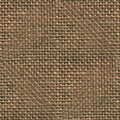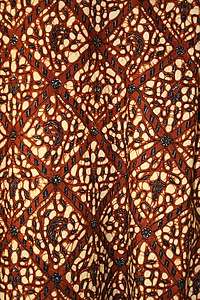Technical textile
A technical textile is a textile product manufactured for non-aesthetic purposes, where function is the primary criterion.[1] Technical textiles include textiles for automotive applications, medical textiles (e.g., implants), geotextiles (reinforcement of embankments), agrotextiles (textiles for crop protection), and protective clothing (e.g., heat and radiation protection for fire fighter clothing, molten metal protection for welders, stab protection and bulletproof vests, and spacesuits).[2]
The sector is large, growing, and supports a vast array of other industries. The global growth rate of technical textiles is about 4% per year, which is greater than the growth rate of home and apparel textiles, which are growing at a rate of 1% per year. Currently, technical textile materials are most widely used in filter clothing, furniture, hygiene medicals and construction material.
Classification
Technical textiles can be divided into many categories, depending on their end use. The classification system developed by Techtextil, Messe Frankfurt Exhibition GmbH, is widely used in Europe, North America and Asia. Techtextil specifies 12 application areas: Agrotech, Buildtech, Clothtech, Geotech, Hometech, Indutech, Medtech, Mobiltech, Oekotech, Packtech, Protech, and Sporttech, Architech (Architectural textile), Military textiles, Autotech (Automobile textiles), Smartech (Smart Textiles), Wearable computers, .[2] These are sometimes spelled Agrotex, Buildtex, Clothtex, Geotex, Hometex, Indutex, Medtex, Mobiltex, Oekotex (Ecotex), Packtex, Protex and Sportex[3]
Buildtech (Construction Textiles)
Construction textiles are used in: construction concrete reinforcement, façade foundation systems, interior construction, insulations, proofing materials, air conditioning, noise prevention, visual protection, protection against the sun, building safety.
An interesting and aesthetic appealing application is the use of textile membranes for roof construction. This area is also referred to as textile architecture. PVC coated high tenacity PES, teflon coated glass fibre fabrics or silicone coated PES are used for their low creep properties. Splendid examples of such construction are found in football stadia, airports and hotels.
Clothtech (Clothing Textiles)
Technical textiles for clothing applications. Especially in the finishing process where fabric is treated under pressure and high temperature the technical textile supports the fabric for smooth processing. This is usually the blend of polyester, modal, viscose, nylon, etc.
Geotech (Geotextiles)
These are used in reinforcement of embankments or in construction work.[4] The fabrics in geo textiles are permeable fabrics and are used with soils having ability to separate, filter, protect or drain. The application areas include civil engineering, earth and road construction, dam engineering, soil sealing and in drainage systems. The fabric used in it must have good strength, durability, low moisture absorption and thickness. Mostly nonwoven and woven fabrics are used in it. Synthetic fibers like glass, polypropylene and acrylic fibers are used to prevent cracking of the concrete, plastic and other building materials. Polypropylene and polyester are used in geo textiles and dry/liquid filtration due to their compatibility.
Hometech (Domestic Textiles)
Textiles used in a domestic environment - interior decoration and furniture, carpeting, protection against the sun, cushion materials, fireproofing, pillows, floor and wall coverings, textile reinforced structures/fittings.
In the contract market such as for large area buildings, ships, caravans, busses, ... fire retardant materials are used. Fire retardant properties are obtained either through the use of inherent fire retardant fibres such as modacryl or through the application of a coating with fire retardant additives (bromide of phosphorus compounds).
Indutech (Industrial Textiles)
Textiles used for chemical and electrical applications and textiles related to mechanical engineering. Silk-screen printing, filtration, plasma screens, propulsion technology, lifting/conveying equipment, sound-proofing elements, melting processes, roller covers, grinding technology, insulations, seals, fuel cell.
Lifting textiles
Technical textiles for Lifting applications. Used in process of lifting heavy goods. The textile produced is strongly woven with High tenacity yarns and the fabric is treated with heat and high temperature controlling its elongations. This is usually made of High tenacity polyester and Nylon however HMPE yarns as Dyneema are also used.
Mobiltech (Textiles used in transport; automotive and aerospace)
These textiles are used in the construction of automobiles, railways, ships, aircraft and spacecraft. Examples are Truck covers (PVC coated PES fabrics), car trunk coverings (often needle felts), lashing belts for cargo tie downs, seat covers (knitted materials), seat belts, non-wovens for cabin air filtration (also covered in indutech), airbags, parachutes, boats (inflatable), air balloons.
These textiles are used in automobiles, ships and aircraft. Many coated and reinforced textiles are used in materials for engines such as air ducts, timing belts, air filters, non-wovens for engine sound isolation... A number of materials are also used in the interior of cars. The most obvious are seat covers, safety belts and airbags but one can find textiles also for the sealing. Nylon gives strength and its bursting strength being high is used as air bags in cars.
Carbon composites are mostly used in the manufacture of aeroplane parts while carbon fibre is used for making higher end tyres. High tensile polyester is used for making air balloons.
Oekotech or Ecotech (Ecological Protection Textile)
New applications for textiles in environmental protection applications - floor sealing, erosion protection, air cleaning, prevention of water pollution, water cleaning, waste treatment/recycling, depositing area construction, product extraction, domestic water sewerage plants.
Packtech (Packaging textiles)
Packaging, silos, containers, bags, lashing straps, canvas covers, marquee tents.
Protech (protective textiles)
The main target of the technical protective fabrics is to improve people safety in their workplaces. A technical protective fabric can save a worker's life, that's why, most of them are mainly used to manufacture PPE (personal protective equipment). The demand of these fabrics is growing around the world thank to the sensibilitization of the society, requiring more safety at work. There are some organizations around the world (ASTM and ISO) which describe the requirements and regulations, to fulfill by a fabric, to be considered as a technical protective fabric. The aim of a technical protective fabric isn't fashion, they are designed to have extra values in protection, against some hazards.
Nowadays it can be found in the market, technical fabrics which protect of:
- High temperatures (insulating, firefighters)
- burns (flame, convective and radiant heat, firefighters, ATEX area)
- Electric arc flash discharge (plasma explosion, Electric companies)
- molten metal impacts (foundries)
- metal sparks (welding)
- acid environment (petrochemical, gas, refineries, chemical)
- bullet impact (military, security)
- cut resistant (gloves, glass industry)
- astronaut's suits
- Left over food packets
- Paid banks
These fabrics are made of different kind of fibers, because every blend apports different technical characteristics to the fabric:
- Meta-Para aramides – Nomex: high resistance, tear, tensile strength, expensive,
- Wool viscoses polyamide – marlan : repellency of molten metal, heat insulation, transparency.
- Glass fiber - High resistance, insulating.
- Modacrylic cotton – Marko wiki: Marko : electric arc flash protection, comfort, flame-resistant, multinorm, efficient, skin friendly, antistatic.
- Polyamide – Kevlar : extreme resistance, low aging
Sportech (Sports textiles)
Shoes, sports equipment, flying and sailing sports, climbing, angling, cycling, winter and summer sports, indoor sport it can vary from anything including sports bags.
Specific areas of application
Conveyor belts
For industrial applications and in power transmission, technical textiles are used in conveyor belts. Carcass is a fabric inside the conveyor belt, which is responsible for the strength and stretch properties of the belt. This carcass is made with layers of woven fabrics bonded together.
Electronics in textiles
It has been heard that soon textiles will be merged with electronics in all areas. In future wearable computers would be launched, these will not be like advance wrist watches etc., they will contain IC s in fabric to develop fabric keyboards and other wearable computer devices. These types of products are known as Interactive electronic textiles (IET). Research to support IET development is being conducted in many universities. Growing consumer interest in mobile, electronic devices will initiate the demand for IET products.
See also
References
- Tortora, Phyllis G.; Merkel, Robert S. (1996-01-10). Fairchild's Dictionary of Textiles (7th ed.). New York: Fairchild Publications. p. 567. ISBN 9780870057076.
- Techtextil: Application areas. Techtextil, Frankfurt: Trade fair for Technical Textiles and Nonwovens] consulted 28 March 2015
- Resisto Protection Textil GmbH visited 21 August 2008 Archived 15 June 2009 at the Wayback Machine
- http://economictimes.indiatimes.com/news/economy/infrastructure/centre-looks-to-promote-use-of-geo-textiles-in-rural-roads/articleshow/48680614.cms
- Horrocks, A.R.; S.C. Anand. "Handbook of Technical Textiles." The Textile Institute. Woodhead Publishing Limited (2000)


.svg.png)